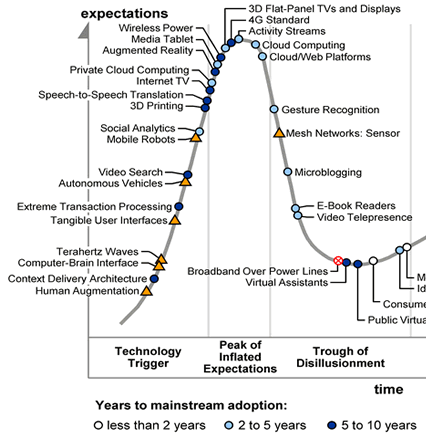Gartner’s Hype Cycle Says Cloud Computing Has Peaked
by Steve O'Keefe on October 12, 2010

2010 Gartner Hype Cycle for Emerging Technologies
The analysts at Gartner have released the latest version of their much-hyped Hype Cycle for Emerging Technologies. The report indicates that poor “cloud computing” has entered the long, disappointing phase of technological maturity, though “private cloud computing” is still ascending the pinnacle of hype.
The Gartner Hype Cycle describes a curve of technological adoption. It plots nearly 2,000 new technologies at one of the five phases of evolution, which Gartner colorfully describes as:
- Technology Trigger
- Peak of Inflated Expectations
- Trough of Disillusionment
- Slope of Enlightenment
- Plateau of Productivity
Gartner bunches the 1,800 technologies it tracks into roughly 80 groupings by technology, topic, or industry. One of the most popular groupings is “emerging technologies,” for which Gartner releases a free Hype Cycle chart (shown above). Gartner Vice President Jackie Fenn summarizes the emerging technologies cycle:
High-impact technologies at the Peak of Inflated Expectations during 2010 include private cloud computing, augmented reality, media tablets (such as the iPad), wireless power, 3D flat-panel TVs and displays, and activity streams, while cloud computing and cloud/Web platforms have tipped over the peak and will soon experience disillusionment among enterprise users.
How quickly the cloud moves along! Last year, “cloud computing” was Gartner’s most popular Hype Cycle. Downloads of the Cloud Computing report, which retails for $1,995, have led all other reports, according to the company’s website.
In trying to determine the source of Gartner’s Hype Cycle, I couldn’t gather much information without paying thousands to download actual reports. On the blog called Mastering the Hype Cycle, Mark Raskino, co-author with Jackie Fenn of the “2010 Hype Cycle Special Report,” explains the process this way:
We have multiple review stages. Each individual technology profile is reviewed by peer specialist analysts, each hype cycle is then reviewed by a wider group of domain analysts. Then those of us in the hype cycle special report team check each area has understood and applied the method properly… to avoid local group think or cross-research inconsistencies.
They make sure the “method” has been applied properly, but they don’t tell you what the method is. How did someone discover this curve? Was this pattern revealed by the analysis of data, or is it speculation? Are technologies forced to fit somewhere in this preassigned sign wave? Who assigns technologies to these positions, if it’s not an analytical process?
British computer scientist and author Richard Veryard, a specialist in the economics of information systems, sized-up the Gartner Hype Cycle on his blog, Demanding Change:
All the points are perfectly on the line. To a scientific mind, this indicates that the coordinates are not based on any real objective measurement, and that the curve itself is not subject to scientific investigation or calibration.
In the most recent Hype Cycle for Emerging Technologies, shown above, Gartner uses essentially three different measures for the X-axis. The Y-axis is simply labeled “Expectations” — the higher the point, the greater the expectations for that technology. The base of the X-axis is labeled “Time,” but immediately above it, “Time” is broken into five stages of development, which take varying amounts of time. Also, the icons used to plot each technology have their own time constraints, indicating how many “years to mainstream adoption.” The result is a confusing popularity contest, not an analytical tool.
How would Gartner account for the decline of MySpace simultaneously with the rise of Facebook? I notice that social networking is nowhere on the emerging technologies chart, even though virtual worlds are, and blogging is too.
Gartner produces 75 Hype Cycles a year, retailing at $1,995 each. It charges the same for outdated reports going back five years. Where do you think Hype Cycles fit on the timeline? Are you in the “trough of disillusionment” or the “slope of enlightenment” with Hype Cycles? We’d like to hear your comments on how useful these reports are.
STEVE O’KEEFE
News Editor, Minitrends Blog
Source: “Gartner’s 2010 Hype Cycle Special Report Evaluates Maturity of 1,800 Technologies,” Gartner, Inc., 10/07/10
Source: “The 2010 Gartner Hype Cycles Are Getting Closer,” Gartner’s Mastering the Hype Cycle, 07/08/10
Source: “Technology Hype Curve,” Demanding Change, 09/16/05
Image courtesy Gartner, Inc., used under Fair Use: Commentary.
Comments
2 Responses to “Gartner’s Hype Cycle Says Cloud Computing Has Peaked”
Got something to say?














[…] of thousands of technology company executives. Despite the fact that consulting group Gartner says cloud computing has peaked, DLA Piper’s forecast shows cloud computing as the number-one technology for growth potential […]
[…] Gartner released it’s much-hyped Hype Cycle, boosting visibility in advance of the big event. We criticized the “emerging technology” Hype Cycle here for excluding social […]